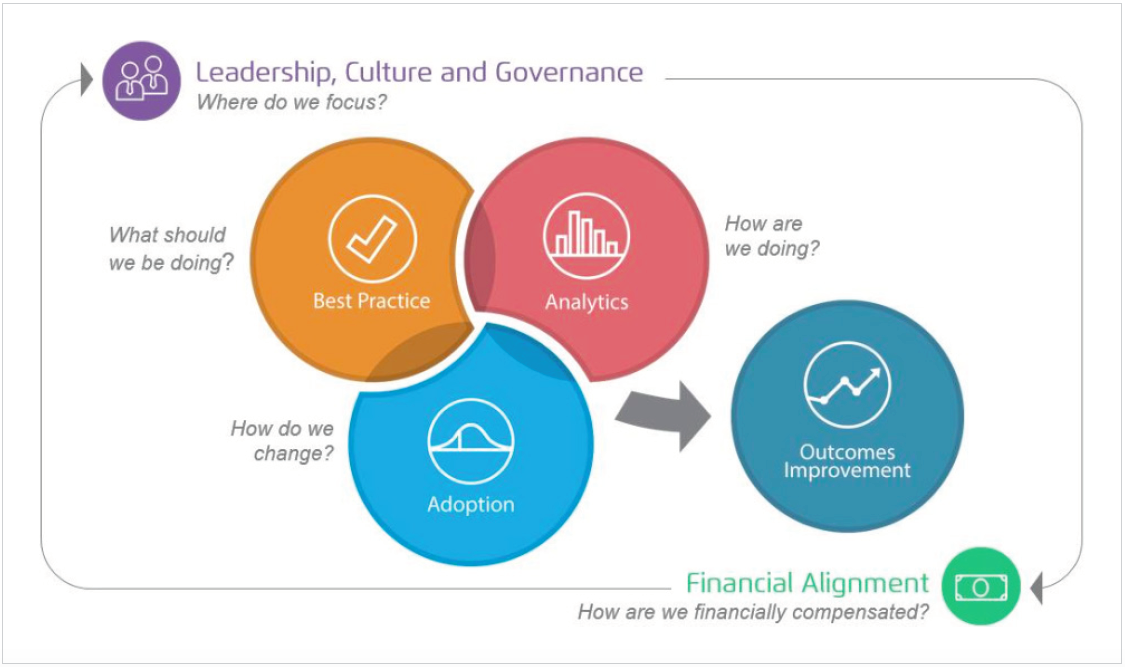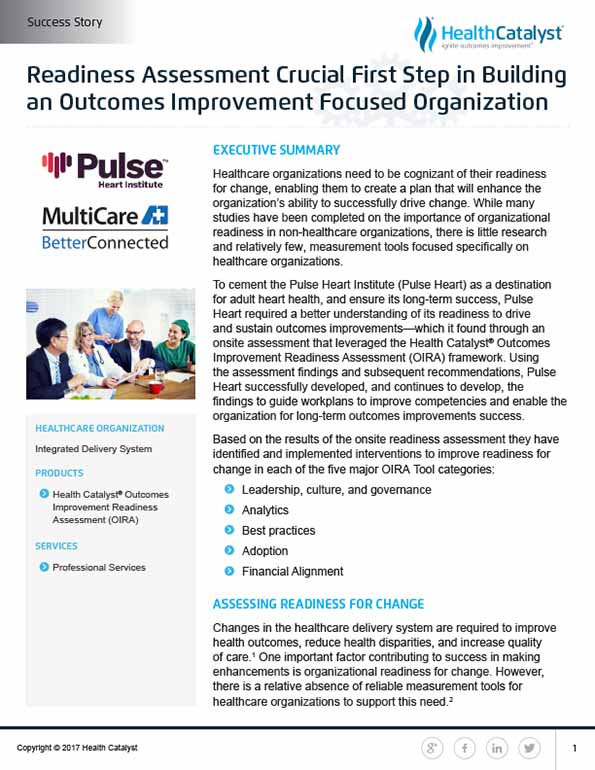Healthcare organizations must assess readiness for change to enhance the ability to drive improvements. The Pulse Heart Institute utilized the Health Catalyst® Outcomes Improvement Readiness Assessment to identify areas for enhancement and implement interventions across five categories, ensuring long-term success in health outcomes.
Healthcare organizations need to be cognizant of their readiness for change, enabling them to create a plan that will enhance the organization’s ability to successfully drive change. While many studies have been completed on the importance of organizational readiness in non-healthcare organizations, there is little research and relatively few, measurement tools focused specifically on healthcare organizations.
To cement the Pulse Heart Institute (Pulse Heart) as a destination for adult heart health, and ensure its long-term success, Pulse Heart required a better understanding of its readiness to drive and sustain outcomes improvements—which it found through an onsite assessment that leveraged the Health Catalyst® Outcomes Improvement Readiness Assessment (OIRA) framework. Using the assessment findings and subsequent recommendations, Pulse Heart successfully developed, and continues to develop, the findings to guide workplans to improve competencies and enable the organization for long-term outcomes improvements success.
Based on the results of the onsite readiness assessment they have identified and implemented interventions to improve readiness for change in each of the five major OIRA Tool categories:
Changes in the healthcare delivery system are required to improve health outcomes, reduce health disparities, and increase quality of care.1 One important factor contributing to success in making enhancements is organizational readiness for change. However, there is a relative absence of reliable measurement tools for healthcare organizations to support this need.2
Pulse Heart is the most recent innovation in care delivery from the Cardiac Study Center and MultiCare Health System. Uniting cardiac, thoracic, and vascular services into one integrated entity, Pulse Heart has a vision of becoming the Pacific Northwest’s destination for adult heart health, offering a comprehensive range of the most advanced cardiac, thoracic, and vascular services available. As Pulse Heart strives to continuously improve care delivery, it looked for a way to thoroughly evaluate its readiness to drive and sustain improvements.
Pulse Heart was established in 2016 with the strategic mission to deliver seamless cardiac services to the communities it serves. It is a physician-led entity, with a dyad management structure, arranged around six patient centers: heart rhythm, advanced heart failure (HF), structural heart disease, peripheral vascular disease, and coronary artery disease prevention.
Creating a new business, particularly one that brings multiple departments, providers, and locations of care together, is challenging work. As a new organization with a different structure, substantial excitement, and a commitment to excel, Pulse Heart was aware that it would face challenges. To ensure its ability to face those challenges, and to ensure long-term success in creating a destination for adult heart health, Pulse Heart needed to better understand its readiness to drive and sustain outcomes improvements.
Pulse Heart’s first step was to find an assessment tool that could reliably determine the organization’s current readiness to drive and sustain outcomes improvement. Pulse Heart’s search led them to Health Catalyst and its on-site assessment, which leverages the OIRA Tool. The OIRA Tool was developed using an integrated literature review of healthcare organizational improvement research. The articles were assessed and used to derive an initial set of competencies. A three-round, modified Delphi nominal group method was used with a panel of 11 subject matter experts (SMEs) to evaluate the relevancy and clarity of the competencies using an item-level content validity index (I-CVI) and a scale content validity index (S-CVI)3. The I-CVI indices ranged from 0.82 to 1.0, exceeding the target established in research literature of 0.78; The S-CVI was 0.92, again exceeding the research literature target of 0.9 for 11 SMEs. A confirmatory factor analysis was also used to evaluate the construct of the OIRA Tool, which showed the model was statistically sound as evidenced by a comparative fit index (CFI) of 0.9504, non-normed fit index (NNFI) of 0.9425, and a root mean square error of approximation (RMSEA) of 0.0466.
The onsite assessment is designed to help organizations identify their highest performing competencies as well as those skills for which there are gaps that require additional development to better drive and sustain outcomes using the OIRA Tool competencies 22 OIRA Tool competencies are grouped into five main keys for success (see Figure 1):

Confident that the OIRA Tool was an assessment that had been validated for clear, understandable, and relevant competencies, and cognizant that a professional services organization, with an outside perspective could provide unbiased feedback, Pulse Heart engaged Health Catalyst. Health Catalyst conducted the onsite assessment, using the OIRA Tool categories and competencies, and provide Pulse Health with its baseline results, suggested recommendations, and suggested an ongoing reassessment of its organizational readiness every 6 to 12 months, or as needed based on major strategic business or organizational changes.
Pulse Heart’s leadership team selected participants for the on-site assessment, contacting people from the centers of excellence, leaders, physicians, nurses, and other key stakeholders across the organization, providing them an opportunity to have their voices heard.
The chance to participate in the assessment created excitement and positive energy, as it was different than previous approaches. Participants were excited to be involved in something new, and confident that the information would be used for improvement. To ensure adequate perspectives and representation, experts from Health Catalyst interviewed 37 cross-discipline individuals from Pulse Heart and the key hospitals they serve, including 18 clinicians/clinical leaders, 14 people in leadership positions, and five front line staff/IT.
Following completion of the onsite assessment, results and recommendations for improvement were shared with the leadership team.
Pulse Heart, following through on its commitment to respect and leverage the onsite readiness assessment findings and subsequent recommendations, actively uses the results to guide the development of workplans. The assessment reassured the team that they were on the right track with actions they had taken and helped set priorities for their future work.
“We know we want to improve quality. To do that, we needed a comprehensive assessment to help us understand our readiness, what is working, and what required change.”
– Jason Parks, President, Pulse Heart Institute
Pulse Heart is using the results of it onsite assessment report as a living document, referring to it frequently to reflect on the organization’s progress, and to ensure it is developing the competencies required to drive and sustain outcomes improvements. This enables it to deliver on the promise to make Pulse Heart the destination for adult heart health. Additionally, Pulse Heart plans to administer the web-based OIRA Tool in the next several months to establish its overall readiness assessment and competencies baseline scores, and to conduct future onsite assessments, using the results to further refine the organization’s outcomes improvement competencies.




